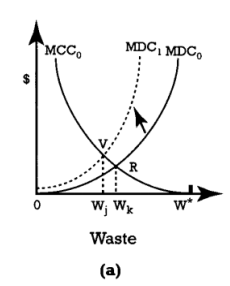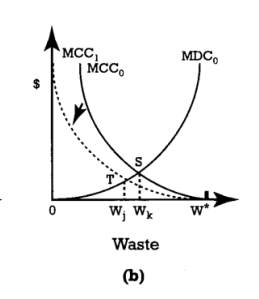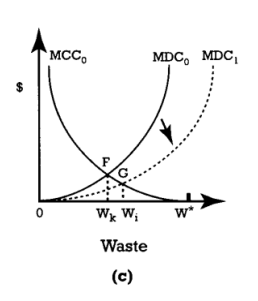Deck 3: Ecological and Technological Determinants of the Trade-Off Between Economic Activity and Environmental Quality
Question
Question
Question
Question
Question
Question
Question
Question
Question
Question
Question
Question
Question
Question
Question
Question
Question
Question
Question
Question
Question
Question
Question
Question
Question

Unlock Deck
Sign up to unlock the cards in this deck!
Unlock Deck
Unlock Deck
1/25
Play
Full screen (f)
Deck 3: Ecological and Technological Determinants of the Trade-Off Between Economic Activity and Environmental Quality
1
Ecological economists always assume that greater utility is derived from the quality of
the physical environment than from the consumption of goods and services.
the physical environment than from the consumption of goods and services.
False
2
Rational behavior requires making a trade-off between consuming goods and loss in
environmental quality.
environmental quality.
True
3
Pollution output, in some form, can never be avoid in the production process.
True
4
The assimilative capacity of the environment is limited in its ability to absorb water and
air wastes, but unlimited with regard to its ability to assimilate air wastes, some of which
can escape to outer space.
air wastes, but unlimited with regard to its ability to assimilate air wastes, some of which
can escape to outer space.

Unlock Deck
Unlock for access to all 25 flashcards in this deck.
Unlock Deck
k this deck
5
Stock pollutants have many biological organisms that help degrade them into harmless
substances.
substances.

Unlock Deck
Unlock for access to all 25 flashcards in this deck.
Unlock Deck
k this deck
6
Generally, pollution reduces the capacity of an environmental medium to withstand
further pollution.
further pollution.

Unlock Deck
Unlock for access to all 25 flashcards in this deck.
Unlock Deck
k this deck
7
There is always a given minimum amount of economic goods that can be produced
without inflicting damage to the natural environment.
without inflicting damage to the natural environment.

Unlock Deck
Unlock for access to all 25 flashcards in this deck.
Unlock Deck
k this deck
8
For a perfectly competitive market to lead to a socially optimal result, resource ownership
must be clearly defined.
must be clearly defined.

Unlock Deck
Unlock for access to all 25 flashcards in this deck.
Unlock Deck
k this deck
9
A poorly cared-for neighborhood park that reduces the property values of nearby homes
is an example of a negative externality.
is an example of a negative externality.

Unlock Deck
Unlock for access to all 25 flashcards in this deck.
Unlock Deck
k this deck
10
Ocean fisheries is good example of a common property resource.

Unlock Deck
Unlock for access to all 25 flashcards in this deck.
Unlock Deck
k this deck
11
Total economic value equals the sum of ecosystem services and intrinsic value.

Unlock Deck
Unlock for access to all 25 flashcards in this deck.
Unlock Deck
k this deck
12
The marginal social cost curve is obtained by the vertical summation of the marginal
private and marginal external cost curves.
private and marginal external cost curves.

Unlock Deck
Unlock for access to all 25 flashcards in this deck.
Unlock Deck
k this deck
13
Hardin did recognize that the government can use coercive power to correct externalities
arising from free access to common property resources.
arising from free access to common property resources.

Unlock Deck
Unlock for access to all 25 flashcards in this deck.
Unlock Deck
k this deck
14
Government intervention in enforcing, monitoring, and establishing clearly defined
property rights should not be defined in terms of transaction costs.
property rights should not be defined in terms of transaction costs.

Unlock Deck
Unlock for access to all 25 flashcards in this deck.
Unlock Deck
k this deck
15
The Coase theorem states that an optimal level of pollution reduction can be achieved by
assigning property rights only to the pollutee.
assigning property rights only to the pollutee.

Unlock Deck
Unlock for access to all 25 flashcards in this deck.
Unlock Deck
k this deck
16
Which one of the following is the best example of a common property resource?
A) A neighborhood park
B) National defense
C) Open-source software
D) A National Park
E) All of the above
A) A neighborhood park
B) National defense
C) Open-source software
D) A National Park
E) All of the above

Unlock Deck
Unlock for access to all 25 flashcards in this deck.
Unlock Deck
k this deck
17
The marginal social cost curve is obtained graphically by ….
A) Horizontally adding the marginal private and marginal external cost curves.
B) Vertically adding the marginal private and marginal external cost curves.
C) Horizontally multiplying the marginal private and marginal external cost curves.
D) Vertically multiplying the marginal private and marginal external cost curves.
E) None of the above
A) Horizontally adding the marginal private and marginal external cost curves.
B) Vertically adding the marginal private and marginal external cost curves.
C) Horizontally multiplying the marginal private and marginal external cost curves.
D) Vertically multiplying the marginal private and marginal external cost curves.
E) None of the above

Unlock Deck
Unlock for access to all 25 flashcards in this deck.
Unlock Deck
k this deck
18
Which one of the following is most likely to be considered a nonrival good?
A) Television
B) A jacket
C) A hot dog
D) A glass of wine
E) All of the above are nonrival goods
A) Television
B) A jacket
C) A hot dog
D) A glass of wine
E) All of the above are nonrival goods

Unlock Deck
Unlock for access to all 25 flashcards in this deck.
Unlock Deck
k this deck
19
Assume that the local museum in your city or town has free entry when it is not too crowded. However, when the number of visitors reaches a threshold level such that it
becomes too crowded it then becomes an example of a(n)
A) Social good.
B) Rival good.
C) Nonrival good.
D) Common property resource
E) None of the above
becomes too crowded it then becomes an example of a(n)
A) Social good.
B) Rival good.
C) Nonrival good.
D) Common property resource
E) None of the above

Unlock Deck
Unlock for access to all 25 flashcards in this deck.
Unlock Deck
k this deck
20
Which one of the following statements about common property resources is false?
A) Social welfare is maximized when private marginal benefits are equal to private
marginal costs.
B) The unregulated outcome does not take into consideration the external costs.
C) The unregulated outcome of a common property resource is inefficient.
D) Government regulation in the form of Pigovian taxes or Individual Transferable
Quotas are potential solutions to the problem of common property resources.
E) Individual profit maximization in the case of common property resources can lead to
the depletion of the resource.
A) Social welfare is maximized when private marginal benefits are equal to private
marginal costs.
B) The unregulated outcome does not take into consideration the external costs.
C) The unregulated outcome of a common property resource is inefficient.
D) Government regulation in the form of Pigovian taxes or Individual Transferable
Quotas are potential solutions to the problem of common property resources.
E) Individual profit maximization in the case of common property resources can lead to
the depletion of the resource.

Unlock Deck
Unlock for access to all 25 flashcards in this deck.
Unlock Deck
k this deck
21
Which of the following statements about the tragedy of the commons is false?
A) The tragedy of the commons represents an inefficient outcome.
B) The tragedy of the commons is a type of negative externality.
C) The tragedy of the commons is almost impossible to avoid.
D) The tragedy of the commons can result from free markets with a common property
resource.
E) The term "tragedy of the commons" was popularized by Garret Hardin.
A) The tragedy of the commons represents an inefficient outcome.
B) The tragedy of the commons is a type of negative externality.
C) The tragedy of the commons is almost impossible to avoid.
D) The tragedy of the commons can result from free markets with a common property
resource.
E) The term "tragedy of the commons" was popularized by Garret Hardin.

Unlock Deck
Unlock for access to all 25 flashcards in this deck.
Unlock Deck
k this deck
22
Which one of the following is not an example of a negative externality?
A) Second-hand smoke
B) Increased cancer risks in areas with nuclear waste disposal sites
C) Air pollution
D) Untreated human waste
E) Pollination by bees
A) Second-hand smoke
B) Increased cancer risks in areas with nuclear waste disposal sites
C) Air pollution
D) Untreated human waste
E) Pollination by bees

Unlock Deck
Unlock for access to all 25 flashcards in this deck.
Unlock Deck
k this deck
23
Figure 3A



-Refer to Figure 3A. Assume that one starts at any point that indicates an optimal pollution level. Further assume that there is a technological advancement that shifts the marginal
damage cost downward and to the right. The new optimal level of pollution will be at which
point?
A) Point "V", panel (a)
B) Point "G", panel (c)
C) Point "S", panel (b)
D) Point "R", panel (a)
E) Point "F", panel (c)



-Refer to Figure 3A. Assume that one starts at any point that indicates an optimal pollution level. Further assume that there is a technological advancement that shifts the marginal
damage cost downward and to the right. The new optimal level of pollution will be at which
point?
A) Point "V", panel (a)
B) Point "G", panel (c)
C) Point "S", panel (b)
D) Point "R", panel (a)
E) Point "F", panel (c)

Unlock Deck
Unlock for access to all 25 flashcards in this deck.
Unlock Deck
k this deck
24
Figure 3A



-Refer to Figure 3A. Assume that one starts at any point that indicates an optimal pollution level. Further assume that there is an educational campaign of awareness that results in a
change in social preference such that environmental quality is believed to be of utmost
importance - increasing its demand. Which panel or panels would indicate a movement in
the curves reflecting this social preference change?
A) Panel (a) only
B) Panel (b) only
C) Panel (c) only
D) Panels (a) and (c)
E) Panel (a) and (b)



-Refer to Figure 3A. Assume that one starts at any point that indicates an optimal pollution level. Further assume that there is an educational campaign of awareness that results in a
change in social preference such that environmental quality is believed to be of utmost
importance - increasing its demand. Which panel or panels would indicate a movement in
the curves reflecting this social preference change?
A) Panel (a) only
B) Panel (b) only
C) Panel (c) only
D) Panels (a) and (c)
E) Panel (a) and (b)

Unlock Deck
Unlock for access to all 25 flashcards in this deck.
Unlock Deck
k this deck
25
Which of the following is true in regard to the optimal level of pollution?
A) What is cheapest for private firms would not be cheapest for society as a whole.
B) With respect to the damage costs there will be a divergence between private and
social costs.
C) In general, the tendency is for private firms to totally ignore the damage costs.
D) In most instances, the economic optimum is associated with a positive level of
pollution emission.
E) All of the above are true.
A) What is cheapest for private firms would not be cheapest for society as a whole.
B) With respect to the damage costs there will be a divergence between private and
social costs.
C) In general, the tendency is for private firms to totally ignore the damage costs.
D) In most instances, the economic optimum is associated with a positive level of
pollution emission.
E) All of the above are true.

Unlock Deck
Unlock for access to all 25 flashcards in this deck.
Unlock Deck
k this deck



